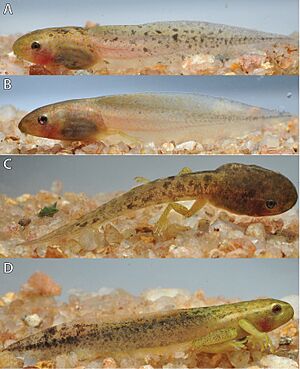Hyperolius castaneus facts for kids
Quick facts for kids Hyperolius castaneus |
|
|---|---|
 |
|
| Conservation status | |
| Scientific classification | |
| Genus: |
Hyperolius
|
| Species: |
castaneus
|
| Synonyms | |
|
Hyperolius latifrons Ahl, 1931 |
|
Hyperolius castaneus is a type of frog found in parts of Africa. It belongs to the family called Hyperoliidae, which are often known as "reed frogs." People sometimes call this frog the Ahl's reed frog, brown reed frog, or montane reed frog. You can find these frogs in the high mountain areas of western Burundi, Rwanda, and Uganda. They also live in the eastern part of the Democratic Republic of the Congo.
Contents
What Does the Brown Reed Frog Look Like?
These frogs are quite small. Adult male frogs are about 20 to 26 millimeters long. This is measured from their snout (nose) to their vent (bottom). Adult female frogs are a bit larger, measuring 27 to 32 millimeters long.
Color and Patterns
The color of Hyperolius castaneus can change a lot!
- Male Frogs: Their backs are usually tan or brown. They might have yellow or brown spots. Sometimes, large yellow patches cover most of their back. These yellow spots can have dark brown centers or edges. Many males have a dark brown stripe. This stripe runs from their nose, through their eye, and often down to their front leg. Their throat is a bright yellow, like a canary. Their belly can be grayish-blue or white. Their legs are salmon red to red, with bright orange-red on the hidden parts of their thighs.
- Female Frogs: Their back color can be orangish-brown or mustard yellow. Most females have a dark brown area near their eyes. This color might stretch from behind the eye to the front leg. Their backs can be plain, or they can have patterns like the males. Some females have big brown patches with bright yellowish-green borders. Their belly is white, and their throat is light pink to grayish-blue. Their legs are similar in color to their bodies. Their hands and feet might be salmon red.
- Both Sexes: The sides and back of both males and females can be a lighter brown. They can also range from light gray to salmon red.
- Young Frogs: When they are young, these frogs are lime green on their backs. They often have a white line along their sides. As they grow older, their colors change to match the adult patterns.
Where Do Brown Reed Frogs Live?
Hyperolius castaneus lives in swamps. These swamps are found in mountain grasslands and forests. They live at high elevations, from about 1,600 to 2,850 meters (about 5,200 to 9,300 feet) above sea level.
Are Brown Reed Frogs Safe?
Scientists first thought this frog was "vulnerable" in 2004. This meant it was at risk of disappearing. However, they later found out that the frog lives in many more places than they first thought. Its habitat covers a large area of about 73,498 square kilometers (about 28,378 square miles).
Because of this discovery, the Hyperolius castaneus is now listed as a species of "least concern". This means it is not currently at high risk. Even though some of its habitat is being lost, there are still many suitable places for these frogs to live. It is considered a common species and can be found in several national parks, which helps protect them.



